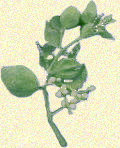Parkwell's
Floral Designs, Inc.
|
.gif)
|
Oklahoma's State Flower
|
.gif)
|
|
 |
Mistletoe
(Phoradendron Serotinum)
|
|
Mistletoe is the state flower of Oklahoma.
Buy state flowers
|
|
Mistletoe is a partial parasite.
The dark green leaves and white berries show up brightly during the fall and winter in trees that have shed their own leaves.
The common name is derived from the ancient belief that mistletoe was propagated from bird droppings.
This belief was related to the then-accepted fact that life could spring spontaneously from dung.
Mistletoe would often appear on a branch or twig where birds had left droppings.
Mistel is the Anglo-Saxon word for dung, and tan is the word for twig.
So, mistletoe means dung-on-a-twig.
Through the centuries, Mistletoe has been associated with many folklore customs.
It has been one of the most magical, mysterious, and sacred plants, endowed with the powers of health, protection, love, and even the ability of bestowing fertility.
It was believed to cure several types of diseases, and was even able to render poisons harmless.
In Europe branches of mistletoe were placed over house and stable doors to prevent the entrance of witches.
The Celts hung sprigs of Mistletoe in their homes to welcome the new year and to ward off evil spirits.
They positioned pieces of the plant above a baby's cradle to protect the newborn from fairy theft.
In parts of England and Wales farmers would give the Christmas bunch of mistletoe to the first cow that calved in the New Year.
This was thought to bring good luck to the entire herd.
Held sacred by the Druids when growing on Valonia Oak.
They believed it would make barren animals fertile if drunk.
Mistletoe was regarded as both a sexual symbol and the soul of the oak.
It was gathered at both mid-summer and winter solstices, and the custom of using mistletoe to decorate houses at Christmas is a survival of the Druid and other pre-Christian traditions.
Mistletoe is still ceremonially plucked on mid-summer eve in some Celtic and Scandinavian countries.
In Scandinavia, mistletoe was considered a plant of peace, under which enemies could declare a truce or warring spouses kiss and make-up.
In some parts of England the Christmas mistletoe is burned on the twelfth night lest all the boys and girls who have kissed under it never marry.
A man should pluck a berry when he kisses a woman under the mistletoe, and when the last berry is gone, there should be no more kissing.
In France, the custom linked to mistletoe was reserved for New Year's Day: Au gui l'An neuf (Mistletoe for the New Year).
Today, kisses can be exchanged under the mistletoe any time during the holiday season.
Medical research has found substances in mistletoe that can slow down tumour growth.
The sprigs of this plant are regarded as a symbol of hospitality.
It is thought to bring good luck to anyone who has it.
Considered masculine, it is associated with the sun, and the element of air.
********
|
|
Copyrighted ęParkwell's
All rights are reserved.
|
|